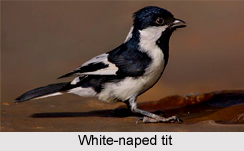 White-Naped Tit is an Indian bird that bears a scientific name "Parus nuchalis" which is sometimes called the White-Winged Tit is a passerine bird in the tit family of Paridae.
White-Naped Tit is an Indian bird that bears a scientific name "Parus nuchalis" which is sometimes called the White-Winged Tit is a passerine bird in the tit family of Paridae.
Concentration of White-Naped Tit
White-Naped Tit is endemic to India where it is found in dry thorn scrub forest in two disjunct populations, in western India and southern India. Its specific name nuchalis means "of the nuchal, nape".
Structure of White-Naped Tit
White-Naped Tit is hard to mistake with its contrasting black and white patterns without the grey wing coverts and back of the partly sympatric cinereous tit (Parus cinereus).
Distribution of White-Naped Tit
White-Naped Tit is very patchily distributed and has been considered to be vulnerable to extinction especially because of the scarcity of suitable habitats particularly nest cavities made by woodpeckers.
Size of White-Naped Tit
White-Naped Tit has the wing-coverts, crown, sides of head, chin, throat, a ventral band running down the breast and belly to the vent black. The cheeks below the eye, the ear-coverts and a patch on the nape are white. The wing has white on the outer primaries and the base of the secondaries. The last tertiaries are completely white. The two outer tail feathers are white while the next has the outer web white and the remaining black. The white of the flanks can be suffused with yellow.
 Discovery of White-Naped Tit
Discovery of White-Naped Tit
White-Naped Tit was discovered in the Eastern Ghats Mountain Range in India near Nellore District by T C Jerdon who received a specimen from a local hunter. A specimen was later obtained in 1863 from near Bangalore and for a long time the species was not observed anywhere in southern India. A O Hume had suggested in that the two populations might represent different species. The southern population was subsequently noted when Salim Ali collected specimens from the Biligiriranga Hills, Chamarajanagar District, Karnataka. The species occurs in the nearby Kaveri valley area where Parus cinereus stupae is also found. The species has also been reported from the Chittoor district of Andhra Pradesh. Salim Ali had claimed that the two species were mutually exclusive; however there is no support for this. The distribution in western India is larger and better known, ranging mainly in areas of Kutch and extending into parts of Rajasthan. A specimen in the British Museum marked as being from Bhutan is considered to be in error.
Behaviour of White-Naped Tit
White-Naped Tit is believed to live at very low densities in small numbers. They are shy and are best detected by their calls which have been described as musical whistling notes tee-whi-whi or see pit-pit-pit-pit. They however appear to show high fidelity to favoured sites. Some roost hollows have been observed to be used for more than six years.
Feeding of White-Naped Tit
White-Naped Tit feed on insects and the berries of Salvadora oleiodes. They may also obtain nectar from the flowers of Capparis aphylla and will sometimes visit rainwater puddles to drink. The breeding season in Rajasthan is during the monsoons, from May to August. The nest is a pad of fibre and hair placed inside a cavity typically on a tree. They choose cavities made by woodpeckers and coppersmith barbets. Nests have been found in old trees of Salvadora persica and Boswellia serrata.
Clutch Size of White-Naped Tit
The clutch size of White-Naped Tit is not known but adults with three young have been observed. The female develops a brood-patch and it is not known if the male incubates. Both parents take part in care of the chicks.
Decline of White-Naped Tit
White-Naped Tit is said to have undergone a rapid population decline in the recent past. The habitat of dense Acacia scrub is severely degraded and fragmented in western India especially due to the collection of old branches with potential nest holes for firewood.



















